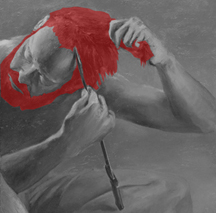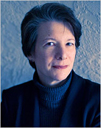
|
|
|
|
|
Class Prep
|
|
|
|
Performing Criticism: The Jewish Prophets
 We saw in the last class that the central "code" in Judaism, the covenant, was re-constructed differently in changing historical circumstances. Today, we will continue to study how that code was appropriated, but in the prophetic part of the canon (the Nevi'im) rather than the Torah. We saw in the last class that the central "code" in Judaism, the covenant, was re-constructed differently in changing historical circumstances. Today, we will continue to study how that code was appropriated, but in the prophetic part of the canon (the Nevi'im) rather than the Torah.-
- There are two parts of the prophetic canon: the historical books about the prophets (their role in the rise and fall of Jewish kingdoms), and the books of oracles by the prophets. The scribes who wrote the book of Deuteronomy in Torah wrote a good chunk of the historical books (their work is called the "Deuteronomistic History"), while the oracles are preserved in the books of 15 individual prophets like Jeremiah and Ezekiel (pictured above).
-
- For today, our central question is how and why the covenant was texted by these historians and prophets. What was going on when they lived, and how did they alter and adapt the covenant to these circumstances? We'll see that the adaptation is not only something they do on animal skin (parchment scrolls), but on their own skin, as the prophets often performed their critique of Israel/Judah with their own bodies.
-
- Read Knight and Levine first, as they'll provide historical context, and then turn to the primary reading. Be able to answer the following questions.
-
- Describe the scope of the Deuteronomistic history (what books it covers in the Bible), and then outline its main themes and characteristic vocabulary. Finally, tie these themes to the time it was written.
- Describe the types of things that prophets characteristically did, and offer a specific example of each either from this chapter or from the primary reading. What are the affordances of "gesture" as a mode of communication?
- Identify the specific prophetic critiques and the forms they take in these four chapters from Ezekiel and Jeremiah. Be able to "place" these two prophets on The Biblical Storyline.
- Compare and contrast the treatment of these prophetic passages in The Action Bible and in the NRSV.
-
-
- Assigned Readings
-
- Primary: Ezekiel 1; 5 and 37; Jeremiah 27 (Action Bible 446-469; read all these passages in the NRSV closely)
-
- Secondary: Knight & Levine, The Meaning of the Bible chapter 13; online class prep
-
- Slides for Lecture on Wednesday (on the Documentary Hypothesis)
-
- Slides for Lecture on this class prep (on the prophets, for Friday)
-
-
- Today's Authors
-
| |
 |
Douglas Knight is the Drucilla Moore Buffington Professor of Hebrew Bible Emeritus and retired Professor of Jewish Studies at Vanderilt University Divinity School in Tenessee. |
| |
 |
Amy-Jill Levine is the University Professor of New Testament and Jewish Studies, the E. Rhodes and Leona B. Carpenter Profesor of New Testament Studies, and Professor of Jewish Studies at Vanderilt University Divinity School in Tenessee. She is a specialist in the Christian Gospel of Matthew and in feminist studies, and is an Orthodox Jew. She will also be our guide through the parables of Jesus when we turn to the New Testament. |
| |
 |
Sergio Cariello is a Brazilian-American comic book artist. He's published with major comic book publishers such as Marvel Comics and DC Comics, and recently has been penciling and inking "The Lone Ranger" for Dynamite Entertainment" and the "Son of Samson" series for Christian publisher Zondervan. |
-
-
- Further Reading
-
- Brueggeman, Walter. The Practice of the Prophetic Imagination. Minneapolis: Fortress, 2012.
-
- --------. The Prophetic Imagination, 2nd ed. Minneapolis: Fortress, 2001. The library has the original 1978 edition.
-
- Day, John, ed. Prophecy and Prophets in Ancient Israel: Proceedings of the Oxford Old Testament Seminar, The Library of Hebrew Bible/Old Testament 531. New York: Bloomsbury T&T Clark, 2014; original 2010.
-
- Doan, William and Terry Giles. Prophets, Performance, and Power: Performance Criticism of the Hebrew Bible. New York: Bloomsbury T&T Clark, 2005.
-
- Ellis, Marc H. Future of the Prophets: Israel's Ancient Wisdom Re-presented. Minneapolis: Fortress, 2014.
-
- Giles, Terry. "Prophets as Performers." Bible Odyssey (n.d.). Online, http://www.bibleodyssey.org/en/passages/related-articles/prophets-as-performers.aspx, accessed 18 October 2015.
-
- Heschel, Abraham Joshua. The Prophets, Perennial Classics. New York: Harper Perennial Modern Classics, 2001; original, 1962. The library has the original 1962 edition.
-
- Lewis, I. M. Ecstatic Religion: An Anthropological Study of Spirit Possession and Shamanism, 2d ed. New York: Routledge, 1989; original, Harmondsworth, England: Penguin, 1971. The library has the original 1971 edition.
-
- Matthews, Victor H. The Hebrew Prophets and Their Social World, 2nd ed. Grand Rapids: Baker Academic, 2012.
-
- Petersen, David L. The Prophetic Literature: An Introduction. Louisville: Westminster John Knox, 2002.
-
- Stökl, Jonathan and Corinne L. Carvalho, eds. Prophets Male and Female: Gender and Prophecy in the Hebrew Bible, the Eastern Mediterranean, and the Ancient Near East, SBL Ancient Israel and Its Literature 15. Atlanta: Society of Biblical Literature, 2013.
-
-
- Video Links
-
-
-
- Acknowledgements
-
|
|
|
|
|
